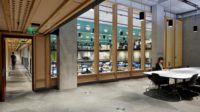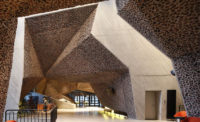Basel, Switzerland
Tucked tight against Switzerland's border with both France and Germany, Basel is a small city that has made room for big business. Its pharmaceutical giants operate from gated compounds, but another of the city's economic engines, the century-old trade-fair site (Messe or Convention Center), is woven into the fabric of a mixed-use urban neighborhood. After many mutations and extensions throughout the 20th century, the Convention Center now comprises an eclectic group of buildings Herzog & de Meuronund Exhibition Square, with a long tail stretching down the city's busy Riehenring. The latest addition, a jagged take on the typical stack of boxes, by Basel-based Herzog & de Meuron, bridges the western end of the square and extends a long row of exhibition halls.
The new wing is topped by a generous 26-foot-high, 720-by-295-foot exhibition space on the third floor. Rather than block the busy thoroughfare it crosses, the design team lifted the structure over the street'to allow for vehicular and pedestrian passage below'resting it on a pair of glazed podiums. They pierced through the center of the suspended exhibition halls to form a giant oculus, which floods the resulting underpass with sunlight by day. This incision hovers above a covered public space, dubbed the City Lounge. Flanked by the addition's transparent entrance foyers, this inviting plaza links the square to Clarastrasse, which runs west to the city center.
Though the large void reduces the real estate and flexibility of the exhibition floors above, it was a crucial concession to the community. According to the firm's partner in charge, Stefan Marbach, the project had to be approved by local referendum, so the architects needed to 'somehow balance the functional concerns of the Convention Center, as a private investor, with the public interest.' Conscious that a big box would detract from established public spaces, the architects made sensitive use of both form and program to enhance them. By truncating Exhibition Square, formerly open to the west, they created a defined container that invites occupancy, and by setting the new building apart from an adjacent parking structure, they devised a new path into the square, refining rather than eradicating the city's grain. Additionally, newly installed shops and restaurants rimming the lobbies are turning the lackluster area into a destination.
Remaining elements of the urbanscape that were left untouched reinforce the sense that the City Lounge is a public space. A familiar cobweb of overhead tram wires passes under the building, where there is a convenient tram stop directly beneath the oculus. Here, too, the expansive sweep of glazing adds a layer of permeability between the private interior and the public exterior zones. Concave balconies peel back from the foyers' curvilinear glass walls, drawing the eye into the building and increasing the apparent size of the outdoor room.
Nothing, however, could compromise the ultimate functionality of the orthogonal exhibition halls. So options to ameliorate the building's bulk were restricted to the perimeters of the upper levels. To do this the architects stacked the top two floors, offsetting them in plan and twisting them to vary the building's silhouette, as well as to respect the 'right to light' of the neighboring buildings. They wrapped the seven resulting facade planes in a reflective mesh made of aluminum lamellas shaped to form gill-like openings. Though there are 15,000 individual rigid panels, the cladding reads as a single flexible element, a textile stretched taut over corners and slumping into gentle folds on the long elevations. The ribbonlike lamellas were cut and bent according to a parametric script that translated two-dimensional elevation designs into a three-dimensional model replete with all fabrication information, allowing fast revisions during design development. With just 22 months allowed for construction, there was no margin for error, so a section of the facade was mocked up at full scale to test both the subcontractors' capabilities and the designers' data.
The architects' ability to wring powerful effects from ordinary materials is evident in the resulting exhibition halls. Painted a deep charcoal gray and set behind rows of fluorescent tubes, ceilings textured with exposed structural and service grids work as a neutral backdrop for the exhibition stands while retaining a strong tectonic character. The fusion of light, shadow, and layered materials produces a perceptual ambiguity characteristic of Herzog & de Meuron's work. With the development of the Basel Convention Center, this skill has been successfully deployed at an urban scale to stitch the city into the trade-fair ground.
PeopleOwner: MCH Swiss Exhibition (Basel) Ltd.
Architect:
Personnel in architect's firm who should receive special credit: Project Team: Tobias Winkelmann (Associate, Project Director); Michael Schmidt, Stefan Hörner (Project Manager), Roger Huwyler (Project Architect), Roland Schreiber (Project Architect)
Project Team: Philip Albrecht, Israel Alvarez Matamoros, Michael Bär, Axel Beck, Marcelo Bernardi, Benito Blanco Avellano, Alexander Bürgi, Amparo Casaní Arazo, Estelle Chan,; Francisco de Freitas, Dorothee Dietz, Francis Fawcett, Oliver Franke, Eik Frenzel, Johann Gruber, Sabine Harmuth, Oke Hauser, Wilhelm Heusser, Yuko Himeno, Ursula Hürzeler, Debora Hummel, Thorsten Kemper, Oxana Krause, Sophia Lau, Christian Laviola, Corinne Lopez, Xiaojing Lu, Ulrik Mathiasson, Katja Mezger, Marcello Nasso, Benjamin Olschner, David Palussiere, Dirk Peters, Louis Putot, Susanna Rahm, Holger Rasch, Sebastian Reinhardt, Nina Andrea Renner, Kathrin Riemenschnitter, Nathalie Rinne, Georg Sebastian Schmid, Katja Schneider, Katharina Schwiete, Jochen Seelos, Jan Skuratowski, Johannes Staudt, Matthias Stücheli, Nicolas Venzin, Manuel Villanueva, Thomas von Girsewald, Miriam Waltz, Romy Weber, Léonie Wenz, Gerd Wetzel, Douwe Wieërs, Thomas Wyssen, Claudia Winkelmann, Camillo Zanardini, Christian Zerreis
Engineer(s):
HVAC Engineering
Plumbing Engineering & Coordination of MEP Electrical Engineering
Mechanical Engineering
Consultant(s): Lighting: Bartenbach LichtLabor, Aldrans, Austria Acoustical: Gruner AG, Basel, Switzerland Sustainability Consultant: Ingenieurbüro Stefan Graf, Basel, Switzerland Building Physics: Zimmermann + Leuthe GmbH, Aetigkofen, Switzerland Civil Engineering: Burger & Partner Ingenieure AG, Basel, Switzerland
Facade Engineering: feroplan engineering AG, Chur, Switzerland Geotechnical Consultant: Pfirter + Nyfeler Partner AG, Muttenz, Switzerland Security Consultant: Gruner AG, Basel, Switzerland Traffic Consultant: Rapp Infra AG, Basel, Switzerland Fire Protection: Gruner AG, Basel, Switzerland Door Coordinator: Brütsch Elektronik AG, Uhwiesen, Switzerland Media Concept: iart interactive ag, Basel, Switzerland Structural Survey: Gruner AG Ingenieure und Planer, Basel, Switzerland Survey: Gruner AG Ingenieure und Planer, Basel, Switzerland Technical Planner Gastronomy: axet gmbh, Embrach, Switzerland
Other: General Planner: ARGE GP, Herzog & de Meuron; Burckhardt + Partner AG, Basel, Switzerland Photographer(s): Iwan Baan CAD system, project management, or other software used: AutoCad / Rhinoceros Size: 896,000 square feet Total construction cost: Withheld Completion date: February 2013 |
ProductsStructural system
Manufacturer of any structural components unique to this project:
ARGE, Süssen/Wendeler, Donzdorf/Süssen , Germany
Precast Concrete Columns:
Exterior cladding upper levels:
Facade cladding: Aluminium 3mm; J57S (Novelis Deutschland GmbH); anodized E0/EV1 (BWB-Holding AG) Facade main construction: MONTAWALL MK (MONTANA BAUSYSTEME AG)
Outdoor Ceiling: Cladding: Aluminium 4mm; J57S (Novelis Deutschland GmbH); anodized E0/EV1 (BWB-Holding AG)
Roofing:
Glazing (Facade Ground Floor):
Steel construction: powder-coated IGP-DURA xal 4601 (IGP Pulvertechnik AG)
Doors:
Wood doors: Sliding doors: GEZE Schweiz AG
Interior finishes
Demountable partitions walls: Millwork (handrail foyers): Lachenmeier AG, Basel, Switzerland Paints and stains: Siegrist & Tschour AG, Olten, Switzerland
Product foyer walls: natural pigment paint, kt.COLOR 230.009 snow white (kt.COLOR AG)
Wall coverings Event Hall:
Floor and wall tile:
Flooring mastic asphalt ground floors:
LED-Balustrade Foyer
Lighting Downlights: Zumtobel Licht AG Exterior: Zumtobel Licht AG
Conveyance |














Post a comment to this article
Report Abusive Comment